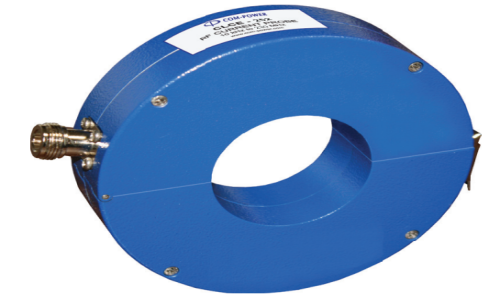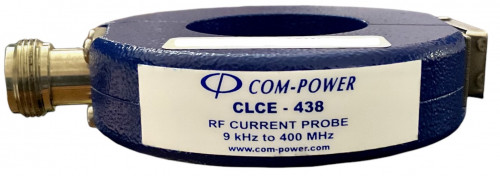List of Current monitoring / sensing probes available from Com-Power.
| Model |
Freq. Range |
Inner Dia. |
Max Current |
| CLCE-332 |
9 kHz-300 MHz |
32 mm |
42 Amps @ 400 Hz |
| CLCE-438 |
9 kHz-400 MHz |
38 mm |
30 Amps @ 400 Hz |
| CLCE-1032 |
9 kHz-1000 MHz |
32 mm |
135 Amps @ 400 Hz |
| CLCE-252 |
9 kHz – 230 MHz |
52 mm |
200 A @ 400 Hz (typical) |
| CLCE-452 V2 |
9 kHz – 400 MHz |
52 mm |
100 A @ 400 Hz (typical) |
CLCE‑252:
Designed for high-current applications, this probe features a large 52 mm aperture and supports up to 200 A at 400 Hz across a 9 kHz–230 MHz range, ideal for thick cable bundles in compliance testing.
CLCE‑452 V2:
This updated version offers a 52 mm aperture and operates from 9 kHz to 400 MHz, making it suitable for medium- to high-current RF monitoring in both commercial and military EMC testing scenarios.
CLCE‑332
This split‑core ferrite clamp probe covers 9 kHz–300 MHz with a 32 mm aperture and handles up to 42 A at 400 Hz. It’s calibrated individually, supports CISPR, MIL‑STD 461, DO‑160 standards, and includes a 3‑year warranty.
CLCE‑438
Offering a broader 9 kHz–400 MHz range and a larger 38 mm diameter, the CLCE‑438 is suited for medium current monitoring (30 A @ 400 Hz) in conducted emission and immunity testing environments.
CLCE‑1032
Designed for wideband applications up to 1 GHz, the CLCE‑1032 shares the compact 32 mm inner diameter with the CLCE‑332 but supports heavy currents up to 135 A @ 400 Hz, ideal for high-power cable testing.
Application of RF Current Probes
In general, RF current probes are employed to monitor, or measure, the asymmetrical disturbance RF currents on a wire, cable or cable bundle without making direct conductive contact with the source conductor. The current is measured inductively by clamping the probe around the conductor(s) to be tested. No actual contact is made with the conductor(s), and the insulation is left in place. Essentially, a current probe is a torroidal transformer where the conductor(s) act as a single turn primary, and the probe as a multiple turn secondary.
Current Probe Calibration Fixture
Current probes are calibrated through the use of a calibration fixture which provides a 50Ω coaxial-type transmission line arrangement. The fixture allows the probe to be clamped around the center conductor, while the outer conductor encapsulates the probe on four sides, so that the transmission line characteristics are not compromised. See calibration fixture picture on the following page.
Contact Us
Get a Quote





